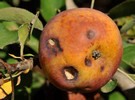In January of this year, one of the biggest nightmares for any fruit farmer became a horrible reality in the Langkloof. Hail. Some farmers were fortunate, some less so and some got wrecked by the falling ice. Ricardo du Preez from Langfontein near Misgund in the Langkloof lost 95% of his crop. Wrecked, that is. The question is, how does one recover from a disaster of that magnitude?
Three minutes. After a whole season of day-by-day dedication, nursing, pruning, helping those trees, the blossoms and budding fruit, it only took three minutes. All gone.
Actually, losing 95% of your crop effectively means losing it all. In reality, a total wipe-out, because trying to rescue the 5% of your undamaged fruit is just too impractical and not cost effective. They will all go for cider or fruit juice. A meagre consolation compared to what your remuneration should have been on the export market. And yes, there is the umbrella of insurance, but between the juice and the pay-out, you are still not where that bumper crop would’ve got you.
95% of your crop effectively means losing it all. In reality, a total wipe-out, because trying to rescue the 5% of your undamaged fruit is just too impractical and not cost effective. They will all go for cider or fruit juice. A meagre consolation compared to what your remuneration should have been on the export market. And yes, there is the umbrella of insurance, but between the juice and the pay-out, you are still not where that bumper crop would’ve got you.
The Langkloof is a unique and somewhat enigmatic pome and stone fruit production area. However, producing 20% of all apples in South Africa, it is crucial for the industry. And it is enigmatic because, at present the Langkloof, basically in its entirety, has been in a scorching drought for seven years. Still it produces. Yet, when the water came in January, it came in the form of ice.
